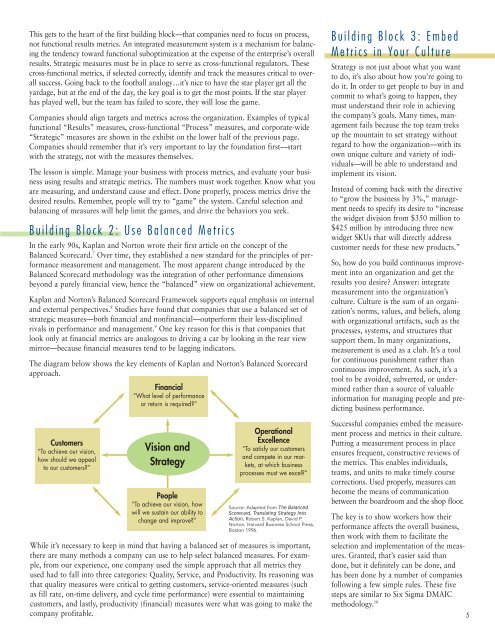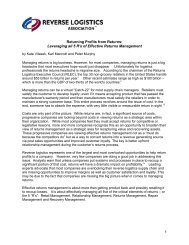is your metrics program measuring up? - Supply Chain Visions
is your metrics program measuring up? - Supply Chain Visions
is your metrics program measuring up? - Supply Chain Visions
Create successful ePaper yourself
Turn your PDF publications into a flip-book with our unique Google optimized e-Paper software.
Th<strong>is</strong> gets to the heart of the first building block—that companies need to focus on process,<br />
not functional results <strong>metrics</strong>. An integrated measurement system <strong>is</strong> a mechan<strong>is</strong>m for balancing<br />
the tendency toward functional suboptimization at the expense of the enterpr<strong>is</strong>e’s overall<br />
results. Strategic measures must be in place to serve as cross-functional regulators. These<br />
cross-functional <strong>metrics</strong>, if selected correctly, identify and track the measures critical to overall<br />
success. Going back to the football analogy…it’s nice to have the star player get all the<br />
yardage, but at the end of the day, the key goal <strong>is</strong> to get the most points. If the star player<br />
has played well, but the team has failed to score, they will lose the game.<br />
Companies should align targets and <strong>metrics</strong> across the organization. Examples of typical<br />
functional “Results” measures, cross-functional “Process” measures, and corporate-wide<br />
“Strategic” measures are shown in the exhibit on the lower half of the previous page.<br />
Companies should remember that it’s very important to lay the foundation first—start<br />
with the strategy, not with the measures themselves.<br />
The lesson <strong>is</strong> simple. Manage <strong>your</strong> business with process <strong>metrics</strong>, and evaluate <strong>your</strong> business<br />
using results and strategic <strong>metrics</strong>. The numbers must work together. Know what you<br />
are <strong>measuring</strong>, and understand cause and effect. Done properly, process <strong>metrics</strong> drive the<br />
desired results. Remember, people will try to “game” the system. Careful selection and<br />
balancing of measures will help limit the games, and drive the behaviors you seek.<br />
Building Block 2: Use Balanced Metrics<br />
In the early 90s, Kaplan and Norton wrote their first article on the concept of the<br />
Balanced Scorecard. 7 Over time, they establ<strong>is</strong>hed a new standard for the principles of performance<br />
measurement and management. The most apparent change introduced by the<br />
Balanced Scorecard methodology was the integration of other performance dimensions<br />
beyond a purely financial view, hence the “balanced” view on organizational achievement.<br />
Kaplan and Norton’s Balanced Scorecard Framework s<strong>up</strong>ports equal emphas<strong>is</strong> on internal<br />
and external perspectives. 8 Studies have found that companies that use a balanced set of<br />
strategic measures—both financial and nonfinancial—outperform their less-d<strong>is</strong>ciplined<br />
rivals in performance and management. 9 One key reason for th<strong>is</strong> <strong>is</strong> that companies that<br />
look only at financial <strong>metrics</strong> are analogous to driving a car by looking in the rear view<br />
mirror—because financial measures tend to be lagging indicators.<br />
The diagram below shows the key elements of Kaplan and Norton’s Balanced Scorecard<br />
approach.<br />
Customers<br />
“To achieve our v<strong>is</strong>ion,<br />
how should we appeal<br />
to our customers?”<br />
Financial<br />
“What level of performance<br />
or return <strong>is</strong> required?”<br />
V<strong>is</strong>ion and<br />
Strategy<br />
People<br />
“To achieve our v<strong>is</strong>ion, how<br />
will we sustain our ability to<br />
change and improve?”<br />
Operational<br />
Excellence<br />
“To sat<strong>is</strong>fy our customers<br />
and compete in our markets,<br />
at which business<br />
processes must we excel?”<br />
Source: Adapted from The Balanced<br />
Scorecard, Translating Strategy Into<br />
Action, Robert S. Kaplan, David P.<br />
Norton, Harvard Business School Press,<br />
Boston 1996.<br />
While it’s necessary to keep in mind that having a balanced set of measures <strong>is</strong> important,<br />
there are many methods a company can use to help select balanced measures. For example,<br />
from our experience, one company used the simple approach that all <strong>metrics</strong> they<br />
used had to fall into three categories: Quality, Service, and Productivity. Its reasoning was<br />
that quality measures were critical to getting customers, service-oriented measures (such<br />
as fill rate, on-time delivery, and cycle time performance) were essential to maintaining<br />
customers, and lastly, productivity (financial) measures were what was going to make the<br />
company profitable.<br />
Building Block 3: Embed<br />
Metrics in Your Culture<br />
Strategy <strong>is</strong> not just about what you want<br />
to do, it’s also about how you’re going to<br />
do it. In order to get people to buy in and<br />
commit to what’s going to happen, they<br />
must understand their role in achieving<br />
the company’s goals. Many times, management<br />
fails because the top team treks<br />
<strong>up</strong> the mountain to set strategy without<br />
regard to how the organization—with its<br />
own unique culture and variety of individuals—will<br />
be able to understand and<br />
implement its v<strong>is</strong>ion.<br />
Instead of coming back with the directive<br />
to “grow the business by 3%,” management<br />
needs to specify its desire to “increase<br />
the widget div<strong>is</strong>ion from $350 million to<br />
$425 million by introducing three new<br />
widget SKUs that will directly address<br />
customer needs for these new products.”<br />
So, how do you build continuous improvement<br />
into an organization and get the<br />
results you desire? Answer: integrate<br />
measurement into the organization’s<br />
culture. Culture <strong>is</strong> the sum of an organization’s<br />
norms, values, and beliefs, along<br />
with organizational artifacts, such as the<br />
processes, systems, and structures that<br />
s<strong>up</strong>port them. In many organizations,<br />
measurement <strong>is</strong> used as a club. It’s a tool<br />
for continuous pun<strong>is</strong>hment rather than<br />
continuous improvement. As such, it’s a<br />
tool to be avoided, subverted, or undermined<br />
rather than a source of valuable<br />
information for managing people and predicting<br />
business performance.<br />
Successful companies embed the measurement<br />
process and <strong>metrics</strong> in their culture.<br />
Putting a measurement process in place<br />
ensures frequent, constructive reviews of<br />
the <strong>metrics</strong>. Th<strong>is</strong> enables individuals,<br />
teams, and units to make timely course<br />
corrections. Used properly, measures can<br />
become the means of communication<br />
between the boardroom and the shop floor.<br />
The key <strong>is</strong> to show workers how their<br />
performance affects the overall business,<br />
then work with them to facilitate the<br />
selection and implementation of the measures.<br />
Granted, that’s easier said than<br />
done, but it definitely can be done, and<br />
has been done by a number of companies<br />
following a few simple rules. These five<br />
steps are similar to Six Sigma DMAIC<br />
methodology. 10<br />
5




